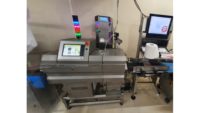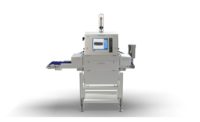In today’s information-driven, data-rich society, consumers increasingly want and expect to know more about where their food was raised, processed and produced. For meat and poultry, that means extending back as far as possible from the plate to the farm.
On the farm and feedlot, tools like radio frequency identification tags help track animals through the system. In processing plants, meat and poultry companies can deploy advanced x-ray inspection systems that not only help find and reject contaminants but provide greater traceability during processing and packaging. Eagle Product Inspection offers a range of x-ray systems that enable processors to enhance product safety and integrity and also improve tracking capabilities.
To enable traceability, Eagle’s x-ray machines used for fresh/raw, in-process and packaged products are powered by SimulTask PRO software. The software – including the latest SimulTask 5 platform releasing in early 2018 – allows managers to easily access statistics and reports on product inspected at several stages of processing. Eagle’s x-ray machines can be equipped with proprietary TraceServer software that records the x-ray inspection process and related production data. The program is scalable and can access data from customer-provided programs, consolidating information into one centralized database.
George Humphries, Senior Technical Specialist for Eagle Product Inspection, uses an example of boxed meats, which are often shipped with barcodes that lead to greater product detail. “Processors can capture a moment in time and send it along. That information is stored and easily retrieved via barcode in the event of any question of product safety or integrity,” he says.
For meat and poultry exports, x-ray technology also ensures that processors are shipping products that are free from bones, given the fact that some countries ban shipment of bone-in products. “Again, by tracking things by barcode and with attached x-ray information, processors are working toward item-level traceability, which is something we’ll move to in the future,” Humphries says.
In addition to having information on hand about when, how and by whom product was inspected, x-ray technology provides other key metrics. “As processors need to show traceability in their production for audits, many have gone further and found that by having better metrics, they can see more about their processes,” continues Humphries. “It started out for food safety and risk mitigation, but it’s turned into process analysis that offers a variety of benefits.”
When working with meat and poultry customers, Eagle’s experts visit plants to help processors identify “pain points” and areas for improvements. “We’ll look at the raw ingredient side, then look at the points in which product is being processed and again at post-processing with boxes, overwrap or individual servings,” Humphries says. “It’s not only about increasing efficiencies, but becoming more consistent.”
Among Eagle’s x-ray solutions for red meat and poultry is the RMI 400, designed for superior bone and contaminant detection with a rugged construction that can withstand stringent sanitation and hygiene requirements. Eagle’s Pack 720 PRO automatically inspects boxes of multiple products and multi-lane applications, while the Eagle FA3/M is a multi-application system that conducts inline fat measurement as well as contaminant detection for fresh, chilled, frozen and hot-boned loose, bulk, frozen or tempered meat blocks, as well as unwrapped meat conveyed in plastic crates.
To learn more about Eagle’s latest x-ray technologies and software systems that provide manufacturers with improved traceability, visit https://www.eaglepi.com.




Report Abusive Comment